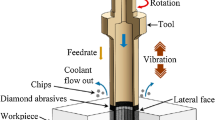Abstract
Machining of plastic materials has become increasingly important in any engineering industry subsequently the prediction of cutting forces. Forces quality has greater influence on components, which are coming in contact with each other. So it becomes necessary to measure and study machined forces and its behavior. In this research work, experimental investigations are conducted to determine the effects of cutting conditions and tool geometry on the cutting forces in the turning of the unidirectional glass fiber reinforced plastics (UD-GFRP) composites. In this experimental study, carbide tool (K10) having different tool nose radius and tool rake angle is used. Experiments are conducted based on the established Taguchi’s technique L18 orthogonal array on a lathe machine. It is found that the depth of cut is the cutting parameter, which has greater influence on cutting forces. The effect of the tool nose radius and tool rake angles on the cutting forces are also considerably significant. Based on statistical analysis, multiple regression model for cutting forces is derived with satisfactory coefficient (R 2). This model proved to be highly preferment for predicting cutting forces.
Similar content being viewed by others
References
Abrate S, Walton D A. Machining of composite materials (a two part review). Composites Manufacturing, 1992, 3(2): 75–94
Caprino G, Nele L. Cutting forces in orthogonal cutting of unidirectional GFRP composites. Journal Engineering Material Technology, 1996, 118(3): 419–425
Koplev A, Lystrup A, Vorm T. The cutting process, chips and cutting forces in machining CFRP. Composites, 1983, 14(4): 371–376
Wang X M, Zhang L C. Machining damage in unidirectional fibrereinforced plastics. In: Wang J, Scott W, Zhang L, eds. Abrasive Technology-Current Development and Applications. Singapor: World Scientific, 1999, 429–436
Wang X M, Zhang L C. An experimental investigation into the orthogonal cutting of unidirectional fibre-reinforced plastic. International Journal of Machine Tools & Manufacture, 2003, 43(10): 1015–1022
Mahdi M, Zhang L C. A finite element model for the orthogonal cutting of fibre-reinforced composite materials. Journal of Materials Processing Technology, 2001, 113(1–3): 373–377
Mahdi M, Zhang L C. An adaptive three-dimensional finite element algorithm for the orthogonal cutting of composite materials. Journal of Materials Processing Technology, 2001, 113(1–3): 368–372
Sun F H, Wu Z Y, Zhong J W, Chen M. High speed milling of SiC particle reinforced aluminum-based MMC with coated carbide inserts. Key Engineering Materials, 2004, 274–276: 457–462
Palanikumar K, Davim J P. Assessment of some factors influencing tool wear on the machining of glass fibre-reinforced plastics by coated cemented carbide tools. Journal of Materials Processing Technology, 2009, 209(1): 511–519
Paulo Davim J, Silva L R, Festas A, Abrão A M. Machinability study on precision turning of PA66 polyamide with and without glass fiber reinforcing. Materials & Design, 2009, 30(2): 228–234
Hussain S A, Pandurangadu V, Palanikumar K. Surface roughness analysis in machining of GFRP composite by carbide tool (K20). European Journal of Scientific Research, 2010, 41(1): 84–98
Rajasekaran T, Palanikumar K, Vinayagam B K, Prakash S. Influence of machining parameters on surface roughness and material removal rate in machining carbon fiber reinforced polymer material. In: Proceedings of Frontiers in Automobile and Mechanical Engineering (FAME). 2010, 75–80
Mata F, Beamud E, Hanafi I, Khamlichi A, Jabbouri A, Bezzazi M. Multiple regression prediction model for cutting forces in turning carbon-reinforced PEEK CF30. Advances in Materials Science and Engineering, 2010, 2010: 1–7
Adam Khan M, Senthil Kumar A. Machinability of glass fibre reinforced plastic (GFRP) composite using alumina-based ceramic cutting tools. Journal of Manufacturing Processes, 2011, 13(1): 67–73
Rajasekaran T, Palanikumar K, Vinayagam B K. Application of fuzzy logic for modeling surface roughness in turning CFRP composites using CBN tool. Production Engineering Research and Development, 2011, 5(2): 191–199
Hussain S A, Pandurangadu V, Kumar K P. Machinability of glass fiber reinforced plastic (GFRP) composite materials. International Journal of Engineering Science and Technology, 2011, 3(4): 103–118
Yang C L. Optimizing the glass fiber cutting process using the Taguchi methods and grey relational analysis. New Journal of Glass and Ceramics, 2011, 1(01): 13–19
Ntziantzias I, Kechaglas J, Fountas N, Maropoulos S. A cutting force model in turning of glass fiber reinforced polymer composite. In: Proceedings of International Conference on Economic Engineering and Manufacturing Systems, Brasov. 2011, 348–351
Ross P J. Taguchi Techniques for Quality Engineering. New York: McGraw-Hills Book Company, 1988
Roy R K. A Primer on Taguchi Method. New York: Van Nostrand Reinhold, 1990
Author information
Authors and Affiliations
Corresponding author
Rights and permissions
About this article
Cite this article
Gill, S.K., Gupta, M. & Satsangi, P.S. Prediction of cutting forces in machining of unidirectional glass fiber reinforced plastics composite. Front. Mech. Eng. 8, 187–200 (2013). https://doi.org/10.1007/s11465-013-0262-x
Received:
Accepted:
Published:
Issue Date:
DOI: https://doi.org/10.1007/s11465-013-0262-x



